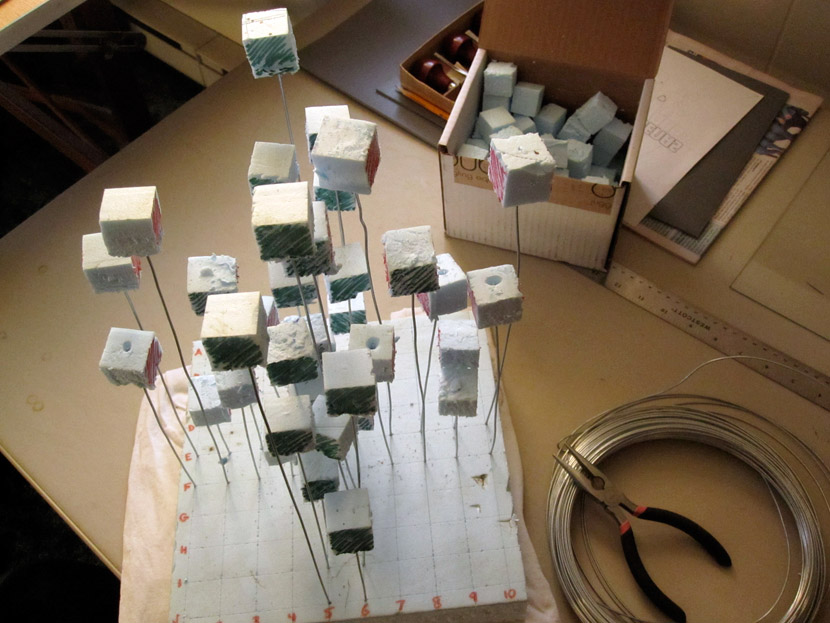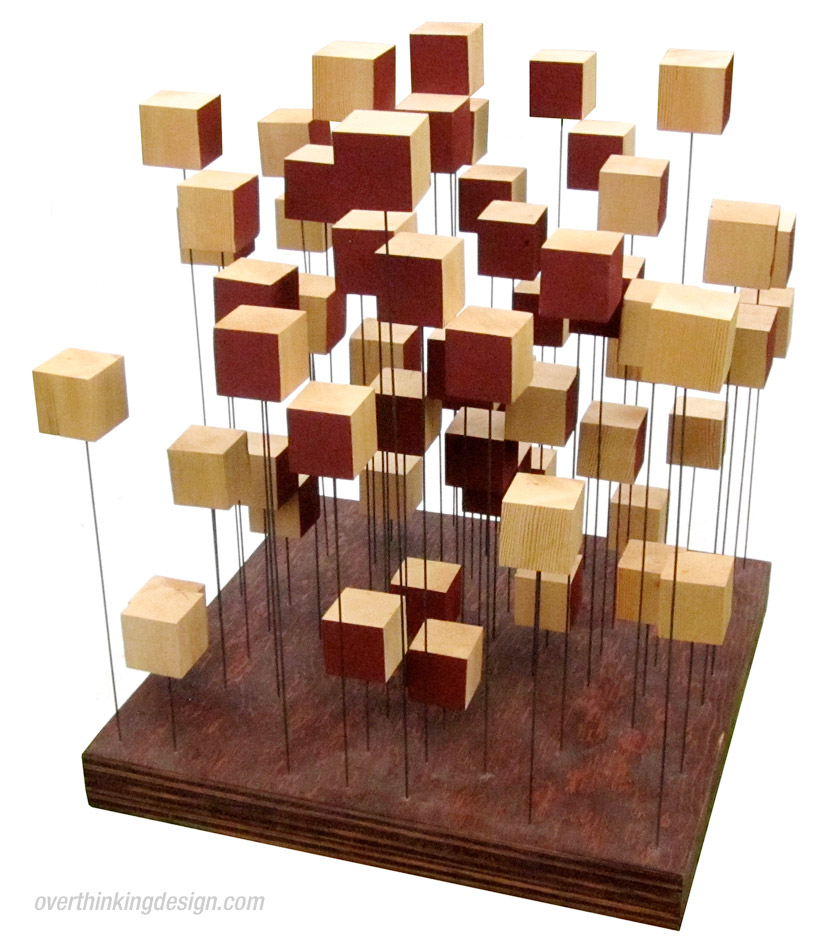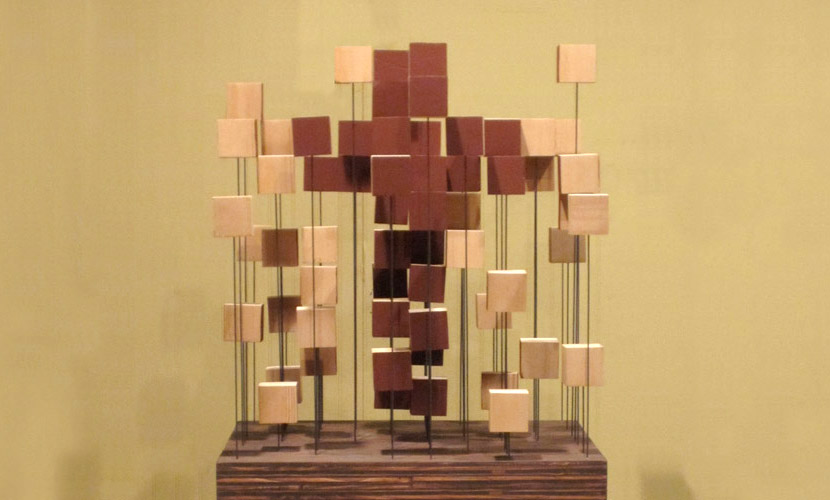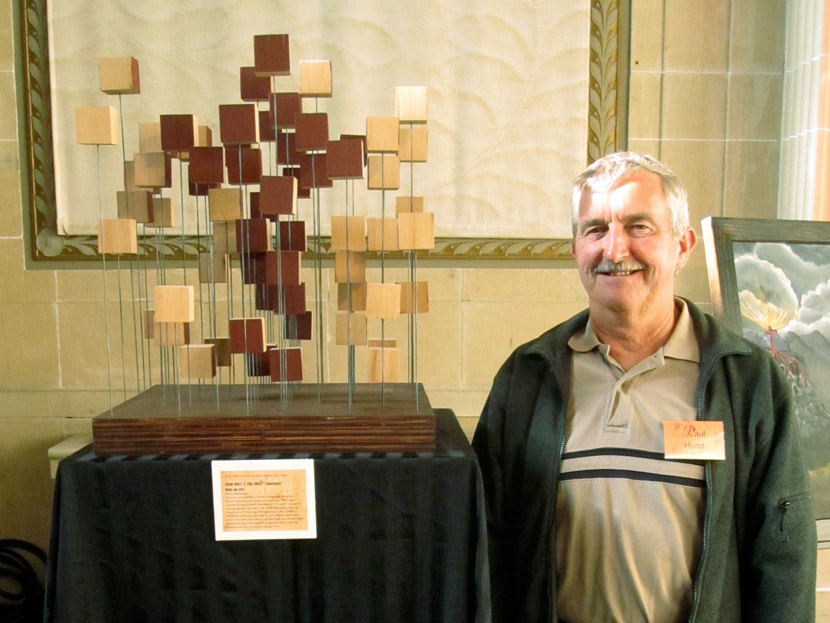For an artist who uses wood as a primarily ingredient, you may expect I have a nice array of woodworking tools. I don’t. How I long for the day when I have a simple table saw! But this is normally not a problem. The amount of money and the quality of tools available to an artist play a role in determining what can be created. These things are taken into account. In my situation, I realize I have some major restrictions in what I can execute with quality. This provides another opportunity for creativity.
That being said, I dream big. Without fail, my first draft ideas have to be simplified to be realistic. In January of 2012 I developed an idea for a piece of artwork to be displayed at that year’s Good Friday art exhibit. The elements involved were not at all complex. Neither was the execution, though it would require some time and methodology. The basic element was a piece of wire mounted vertically onto a wooden base, with a 2″ wooden cube placed atop the wire. This would be repeated approximately 80 times. And this posed some challenges:
1. How do I support the weight of a 2″ wooden cube atop a thin wire without the wire being compromised?
2. How do I go about creating 80 wooden cubes when I only own a circular saw?
3. How do I drill perfectly straight holes into the wooden base and the individual cubes so everything is straight?
Problem number one took some research, but the perfect material was found: piano wire. And surprisingly, many hardware stores carry this item! While relatively thin, it is difficult to bend and is extremely resilient. I visited the architectural salvage barn down the road and found an old pine post from which the cubes could be cut. The cubes would be very lightweight—easily supported by piano wire.
As for the final two problems, they would require special tools: a table saw and a drill press. Was it time to exercise creativity and change my plans? These plans had already been simplified multiple times and I wasn’t willing to change them further. But I had a creative solution: collaboration.
My father owns a table saw, he has access to a drill press, and he is skilled in woodwork. Sure, I could have asked him to let me use these tools, but the thought came to me that he may enjoy building the piece himself! He loves to tinker, he loves to build, and work was slow for this tree worker as it was the dead of winter. I ran the idea by him and he jumped at it.
Suddenly, my role in this project was at an end! I had developed the concept, wrote up blueprints, and even created a half-scale model out of styrofoam. Then I took a seat. I did absolutely none of the creation. It was basically a commissioning, though in a very informal way. I knew my father would do a better job than I would. He is precise, meticulous, and had creative solutions of his own. I anxiously awaited the piece’s completion.

This was the basic plan. One hundred holes, each the exact width of the piano wire, were drilled into a wooden base in a ten by ten grid. (Only 80 of the holes would actually be used.) A drill press was also used to drill a single hole into the middle of one side of each cube. These cubes were kept in their raw state except for some painting. And this is where the meticulous nature of the piece shows its face.
Each cube was assigned a specific position on the grid. Following my blueprints, my father painted specific sides of each cube red. Some had only one painted side, some had two, some had three, and some had none. Each cube was then mounted atop a piece of piano wire. But each wire was assigned a different length between two inches and twenty inches. Piano wire is amazing. It securely held the cubes even at a height of twenty inches.

Upon completion we were left with a three dimensional space approximately 20″ x 20″ x 24″. Within this space 80 cubes floated at various heights and positions. When viewed from most angles, all you saw was a grid of blocks—attractive and intriguing, yet having no significance otherwise. But when viewed straight on from any of the four sides, the painted blocks aligned to show the shape of a cross.

My theme for this piece was prophecy. In the Bible we encounter prophecy starting in the Garden of Eden and continuing to a few hundred years before the birth of Christ. These prophecies—from various time periods, cultures, and events—may at first seem unrelated. But upon study, we see them all point to coming Messiah and His eventual sacrifice on the cross for our sins. The cross comes into focus.

This piece, titled Converge, was something I was unable to execute on my own. Working with others is exciting and it was definitely special to collaborate with my father. Recognize the talents in others. Collaboration is an excellent way to encourage them to exercise their gifts and abilities. It gives them honor. You also become a safety net for those who are hesitant and nervous about stretching themselves. I keep mentioning that collaboration keeps art from becoming all about you, and the “take a seat” method does this better than any other.
Articles in this series on collaboration
- Introduction
- Take a Lead
- Take a Seat
- Take a Role
- Take a Village
- Take a Hand



